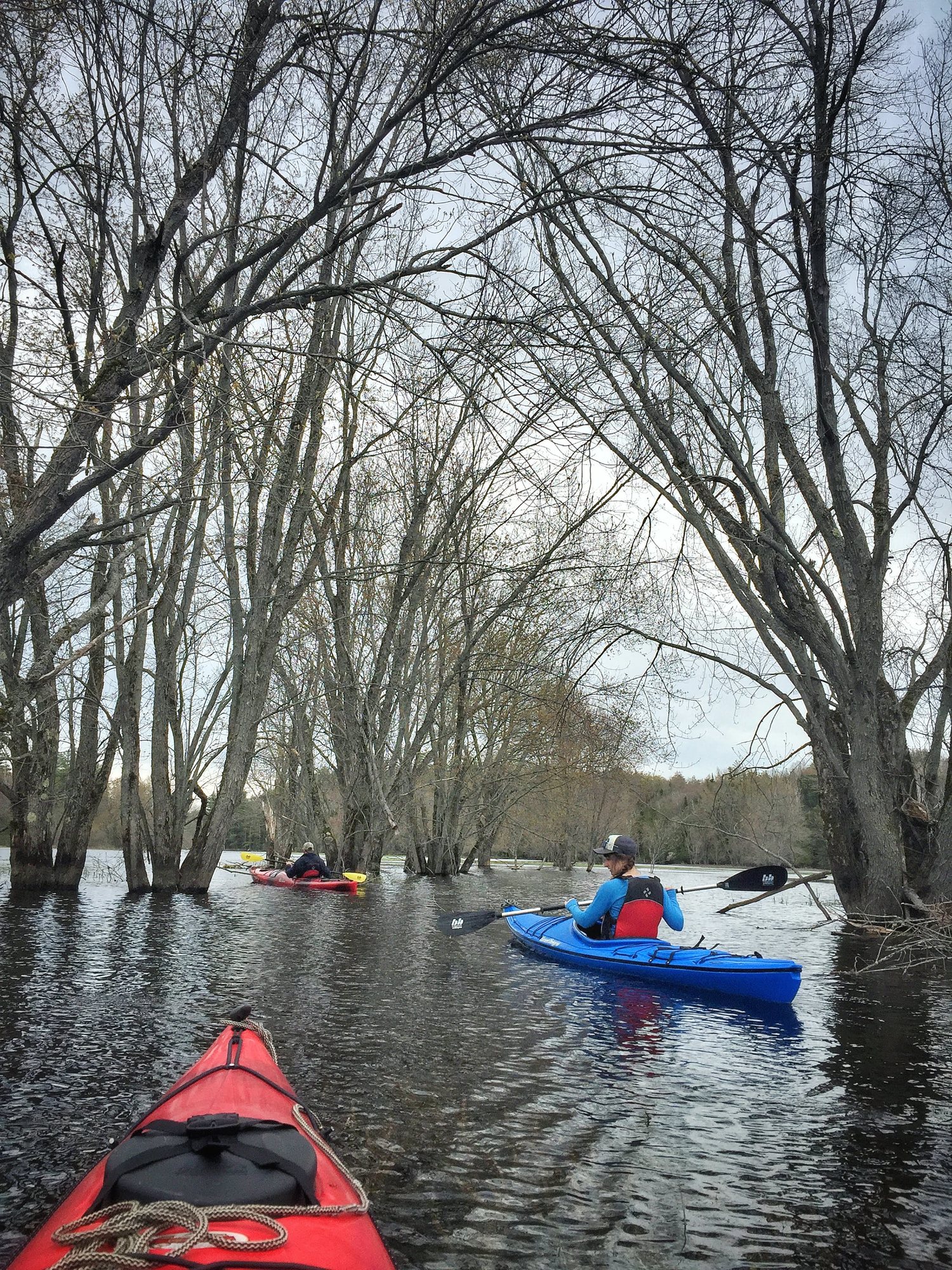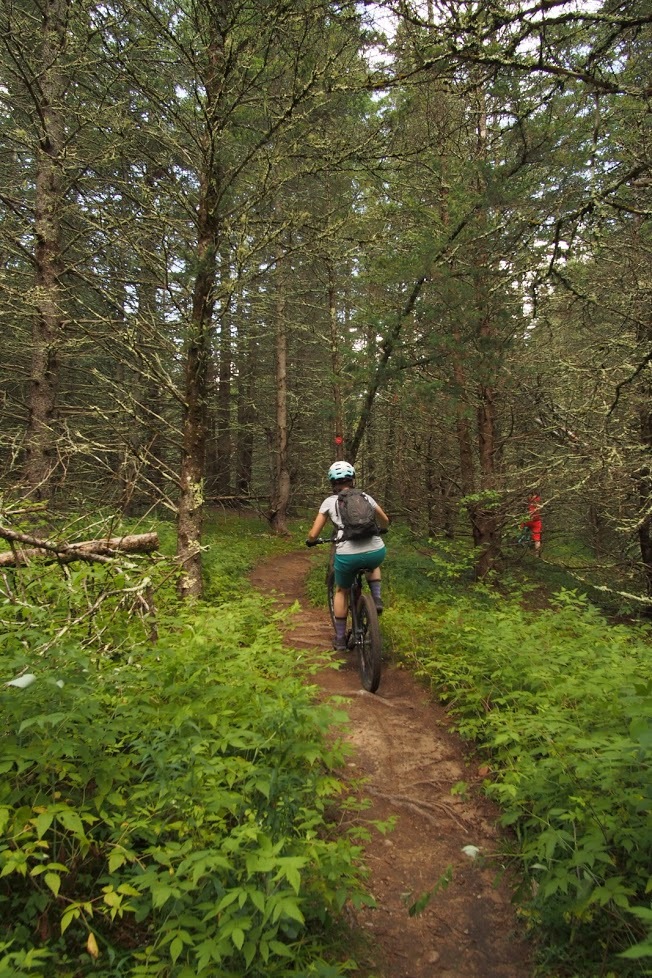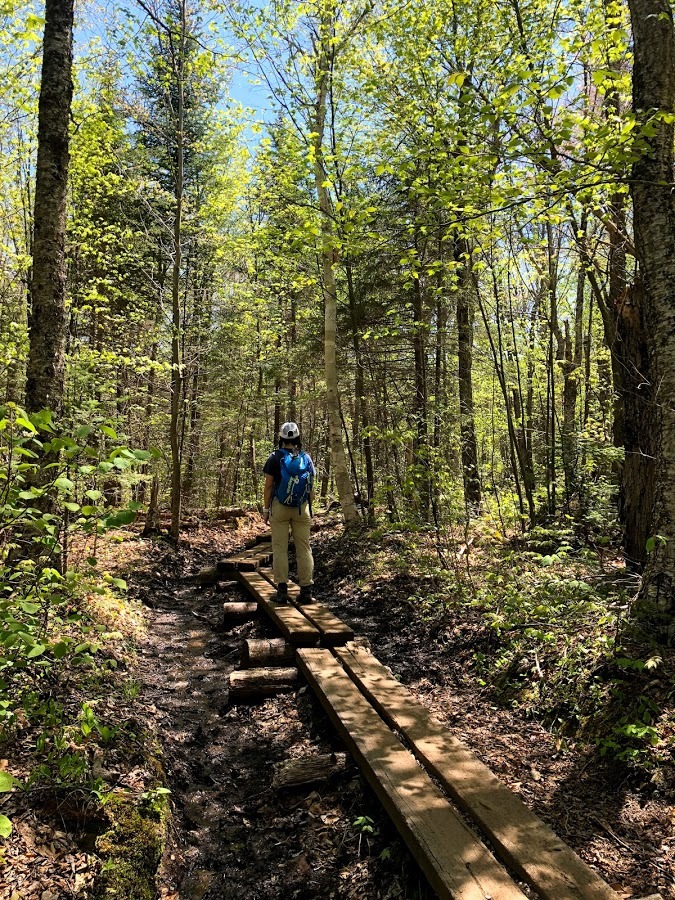|
Have a safe and enjoyable outdoor recreational experience on the lands and waters of the Adirondacks. Properly plan and prepare for your outdoor adventure. Minimize the impact on the mountains and forests, rivers and brooks, ponds and lakes, and the wildlife of the Adirondacks.
Check the Backcountry Information for the Adirondacks web pages for more detailed information on access, outdoor recreation infrastructure, and conditions for those planning to recreate in the Adirondacks. This bulletin provides only the most recent notices.
Muddy Trails Advisory: DEC urges hikers to avoid trails above 2,500 feet to protect trails, soils, and vegetation. Check out this list of Adirondack hikes under 2,500 feet for great alternatives this spring.
-
Walk through the mud, not around it- walking through the mud keeps the pressure in the center of the trail which is designed to take the use. By walking around mud or puddles, trailside vegetation becomes damaged or removed, and softer portions of the trail erode which can create unwanted wider trails. Widened trails mean less habitat for wildlife and insects and more damage to tree roots and vegetation.
-
Wear waterproof boots- Having the proper equipment means you don’t have to choose between walking down the center of the trail or walking around the mud to protect your feet. Choose to walk right down the center of the trail, through the mud.
-
Pack extra wool socks- Every boot has its limit on very wet trails. Bringing extra wool socks to keep your feet warm and dry will give you a more enjoyable hike and allow you to keep walking through the mud.
Emergency Situations: If you get lost or injured, keep calm and stay put. If you have cell service, call the DEC Forest Ranger Emergency Dispatch, 518-891-0235.
Check mountain weather conditions before heading out this weekend.
Packing the proper gear for a hike is very important, and you should be prepared to encounter all conditions. See our recommended packing list and safety tips.
Plan Ahead and Prepare
Weather forecasts and conditions can and do change quickly. Check the current National Weather Service Forecast, and be prepared for the forecasted conditions, or change your plans.
-
Ice, snow and mud present above 2,500 feet: Mixed trail conditions are present on trails in high elevations. DEC urges hikers to hike below 2,500 feet to protect trails, soils, and vegetation. Check out this list of Adirondack hikes under 2,500 feet for great alternatives this spring.
-
Black Flies: The transition to spring means black fly season. Wear clothing that fully covers your body, use bug spray where you are not protected, and bring/wear a bug net to protect yourself from black flies. Wear light-colored clothing. Flies are attracted to dark colors.
-
Stream Crossings: Due to high swift waters, crossing may be dangerous or impossible, especially in the afternoon when snow melt increases. Streams and drainages that are passable in the morning may not be in the afternoon.
-
Bear canisters are required in the High Peaks Wilderness: Bears are coming out of hibernation and are very hungry. If you are planning a backcountry camping trip in the High Peaks Wilderness, bring a bear resistant canister to reduce your chance of encountering a bear. Learn about bear canister facts, how to pack a canister, and how to store your canister properly while camping by visiting the Bear Resistant Canister webpage.
Practice Leave No Trace
Follow proper trail etiquette to maintain minimal impact on the  environment and the natural resources of the Adirondacks, as well as ensure an enjoyable outdoor experience for all visitors by following the Seven Principles of Leave No Trace. environment and the natural resources of the Adirondacks, as well as ensure an enjoyable outdoor experience for all visitors by following the Seven Principles of Leave No Trace.
-
Be a more environmentally friendly camper by using these packing and preparation tips:
- Bring reusable containers for storing leftovers to ensure no food goes to waste.
- Prior to your trip, re-pack any food you are bringing along in reusable containers.
- Reusable cooking utensils and reusable or recyclable dishes cut down on the amount of trash generated.
- Reusable mugs, cups, or bottles that can easily be rinsed or washed cut down on plastic waste. If it's necessary to use plastic, remember to recycle those items.
- Consider using biodegradable/earth-friendly dish soap, sponges, and water basins. Do your dishes at least 150 feet away from any body of water.
- Bring non-toxic sunscreen and bug spray that won't harm waters, plants, and wildlife.
General Conditions/Notices
Learn the conditions you will encounter from Adirondack Backcountry Information.
All
-
Travel: Check NY511 for road closures and conditions.
-
Fire Danger: Moderate in the eastern portion, but low throughout the remainder of the Adirondacks.
-
Biting Insects: Black flies and mosquitoes have emerged heralding “bug season" in the Adirondacks. Follow these steps to minimize the nuisance of biting insects:
- Wear light colored long sleeve shirts and long pants.
- Tuck shirts into pants, button or rubber band sleeves at the wrist, and tuck the bottom of pant legs into your socks.
- Pack a head net to wear when insects are thick.
- Use an insect repellant with DEET, follow label directions.
- Spring in the Adirondacks:

- Mud and water in the lower to middle elevations
- Snow and ice in the upper middle to high elevations
- Check spring recreation tips for a safe and enjoyable outing while minimizing impacts on natural resources and trails.
-
Weather: Check the National Weather Service or NY Mesonow for current conditions and forecasts for the location where you plan to recreate.
-
Water Levels: Rains (and melting snow in the High Peaks Region) are keeping water levels in rivers and streams high and flowing fast. Check the USGS Current Water Data for New York for stream flow of selected waters.
-
Water Temperatures: Water temperatures are very cold.
- We strongly recommend anglers, boaters and paddlers wear personal flotation devices (PFDs aka lifejackets).
- People immersed in cold waters can lose the ability to think clearly and move quickly after only a short time in the water.
- Anglers fishing from shore or wading should wear a personal flotation device.
-
Seasonal Access Roads: All seasonal access roads are closed for mud season. The roads will be reopened after the frost has thawed, the roads are dry, and any necessary repairs and maintenance are completed.
Hikers
-
General Information
-
Muddy Trail Advisory: DEC has issued the annual Spring Muddy Trail Advisory
- Please protect high elevation trails and vegetation and postpone hikes on trails above 2,500 feet until these high elevation trails have dried and hardened.
- Snow and ice are currently melting on high elevation trails.
- Steep trails with thin soils can be dangerous to hike and are susceptible to erosion; and sensitive alpine vegetation is easily damaged.
- Choose any of the numerous trails under 2,500 feet to hike until the advisory is lifted.
- Trail Conditions:
- Mud and water are present on most all trails – protect trails and trailside vegetation by walking through mud and water not around it.
- Monorails of ice and compacted snow may be present on some trails – use crampons and walk on the monorails not on trailside vegetation.
- Water levels are high - low water crossings may be problematic or impossible to cross.
-
Bear Resistant Canister:
- The use of bear-resistant canisters is required for overnight users in the Eastern High Peaks Wilderness between April 1 and November 30.
- All food, toiletries and garbage must be stored in bear-resistant canisters.
- DEC encourages the use of bear-resistant canisters and other practices to avoid negative encounters with bears throughout the Adirondacks.
-
Mountain Summits: Please avoid high elevation mountain summits while the Muddy Trail Advisory is in effect.
Bikers
-
General Information
-
Trail Conditions
-
E-bikes: Electric powered bikes are prohibited on all bike trails on the Forest Preserve.
Boaters and Paddlers
-
General Information
-
Conditions
- Water levels are high and water temperatures are cold
- DEC strongly recommends anglers, boaters and paddlers wear Personal Flotation Devices.
- People immersed in cold waters can lose the ability to think clearly and move quickly after only a short time in the water.
-
DEC Boat Launches: Due to high waters DEC has been unable to install docks at many DEC Boat Launches.
Anglers
-
General Information: Fishing
- Wear proper footwear and use a hiking stick with a carbide tip to access the water.
- Water temperatures are extremely cold.
- Anglers should wear a PFD as a precaution.
- A person falling into the water could quickly lose the ability to keep their head above water.
- Water levels are high due to recent heavy rains.
- Anglers new to brook trout fishing should look to the Guide to Brook Trout Fishing in Adirondack Ponds for assistance.
Climbers
Recent Notices
Notices below reflect recent changes in conditions and recreation infrastructure work that DEC and its partners completed. Check the Backcountry Information for the Adirondacks for ongoing issues and more detailed information.
-
Silver Lake Wilderness: West River Road which provides access into the Whitehouse area is now open.
-
Ferris Lake Wild Forest: The Powley Road remains closed for mud season.
-
High Peaks Wilderness:
-
South Meadow Lane is open to public motor vehicle use.
-
Muddy Trail Advisory: DEC has issued the annual Spring Muddy Trail Advisory

- Please protect high elevation trails and vegetation, and postpone hikes on trails above 2,500 feet until these high elevation trails have dried and hardened.
- Snow and ice are currently melting on high elevation trails.
- Steep trails with thin soils can be dangerous to hike and are susceptible to erosion; and sensitive alpine vegetation is easily damaged.
- Choose any of the numerous trails under 2,500 feet to hike until the advisory is lifted.
-
Garden Trailhead Parking Lot is Closed:
- Hikers can access the Garden Trailhead using the Town of Keene’s Shuttle from Marcy Field.
- The shuttle schedule and additional information is provided by the Town of Keene.
- When the shuttle is not operating, hikers are encouraged to hike other trails in the area.
- The roadway on the Bradley Pond Trail has been washed out by the Harkness Lake Outlet approximately a half mile from the parking lot. Until water levels drop hikers will be unable to cross the outlet.
-
Black River Wild Forest:
- Mill Creek Road is now open.
- Wolf Lake Landing Road and Loop Road remain closed.
- The bridge across the inlet to Bear Lake on the Bear Lake Trail is currently out. All users should be prepared to ford the stream or cross elsewhere.
-
Ha-De-Ron-Dah Wilderness: A correction, the Middle Branch Trail is flooded by beaver activity between Cedar Pond and Middle Branch Lake, not Middle Settlement Lake as currently stated on DEC's web page.
-
Pharaoh Lake Wilderness: The bridge over Alder Brook on the Goose Pond Trail was heavily damaged by ice this spring. Alder Brook cannot be crossed at this time.
-
Saranac Lake Wild Forest:
- The Moose River Pond Road is open.
- The DEC Lake Placid Boat Launch is closed while the bulkhead is being repaired. We expect it to reopen before the Memorial Day holiday weekend.
-
Debar Mountain Wild Forest:
- The Debar Pond access road is open.
Highlighted Hike: Kane Mountain, Caroga Lake, NY
Kane Mountain, located in the Shaker Mountain Wild Forest can be ascended via two routes which can be used to make a loop hike. A fire tower is located on the 2,060-foot summit.
Kane Mountain East Trail is the most direct route, ascending 560 feet and 0.8 mile from the Kane Mountain Trailhead Parking Area to the summit.
Kane Mountain North Trail descends 560 feet and 1.3 miles from the summit to the Kane Mountain Trailhead Parking Area. A 2.1-mile loop hike from Kane Mountain Trailhead Parking Area over the summit of and back to the trailhead can be made using the Kane Mountain North and East Trails
Kane Mountain Trailhead Parking Area: Kane Mountain Trailhead Parking Area is located at the end of the seasonal access Kane Mountain Road off Green Lake Road. (43.1805°N, 74.5040°W)
View Map.

|


 environment and the natural resources of the Adirondacks, as well as ensure an enjoyable outdoor experience for all visitors by following the
environment and the natural resources of the Adirondacks, as well as ensure an enjoyable outdoor experience for all visitors by following the 


